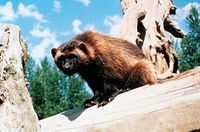Wolverine
2007 Schools Wikipedia Selection. Related subjects: Mammals
| iWolverine | ||||||||||||||
|---|---|---|---|---|---|---|---|---|---|---|---|---|---|---|
 |
||||||||||||||
|
|
||||||||||||||
| Scientific classification | ||||||||||||||
|
||||||||||||||
|
|
||||||||||||||
| Gulo gulo (Linnaeus, 1758) |
The wolverine (Gulo luscus) is the second largest (after the South American giant otter) species of the Mustelidae or weasel family, and is also called the glutton or carcajou. It is the only species currently classified in the genus Gulo. Two subspecies are recognised by some authors: the Old World form Gulo gulo gulo and the New World form G. g. luscus.
The wolverine has been recognized as endangered since 2003. It has been hunted because of the fine quality of its pelt.
Anatomy
The wolverine is a stocky and muscular omnivorous—primarily carnivorous—animal. It has glossy brown hair with stripes of yellow along the sides. The fur is long and dense and does not retain much water. This makes it very resistant to frost in the cold environment where wolverines live. The wolverine can weigh up to 25 kilograms (55 lb, male), and is 110 centimeters (43 in) long with a 20 cm (8 in) tail. It resembles a small bear with a long tail. It has been known to give off a very strong, extremely unpleasant odour, giving rise to the use of the term "skunk bear" and "nasty cat" to describe the animal. This is the second largest animal in the Mustelidae family following the Giant River Otter.
Behaviour
The wolverine is extremely strong for its size and has been known to kill animals as large as moose. Its preference for reindeer has caused it to be hunted significantly in areas depending economically on caribou herds, and its status is sometimes in danger in such regions. It is generally not aggressive toward humans, preferring to avoid human contact. However, because a wolverine will attack an animal caught in a trap, early trappers often tried to kill them. They have been filmed capturing kills from other predators, such as polar bears or a wolf pack. Wolverines are the most ferocious of the Mustelidae family.
Wolverines mate in the summertime, but implantation in the uterus is delayed until early winter, which delays the development of the fetus. Females will often not produce young if food is scarce. The young, usually three or four, are born in the spring. The young kits develop rapidly, becoming adult size within the first year of up to thirteen years of life.
Range
The wolverine primarily lives in arctic regions such as Alaska, northern Canada, Siberia and Scandinavia; wolverines also live in Russia and in the Baltic countries.
Before the wide-spread European settlement of North America, however, the wolverine was found as far south as the Sierra Nevada in California; a few remain in the Rocky Mountains of the United States. The world's present wolverine population is unknown; it appears to have a very low population density throughout its domestic range. Wolverines, especially the males, require great home ranges. The wolverine is still trapped for its fur in some parts of its range.
Trivia
The Norwegian municipality of Bardu has a wolverine in its coat-of-arms.
The University of Michigan uses the wolverine as their mascot.
In the Redwall novel Rakkety tam, Gulo the Savage was a wolverine with a horde of ermines, white foxes, and albino rats.
In the 1984 film Red Dawn, a group of high school students fighting a Soviet invasion of the United States name their group "Wolverines," after their High School's mascot.
